Statue of Yuriy Dolgorukiy, Moscow
|
The Statue of Yuriy Dolgorukiy in Moscow. Photo dated 29 June 1966. | |
| Artist | S. Orlov, A. Antropov, N. Shtamm, V. Andreyev |
|---|---|
| Year | 1954 |
| Type | Bronze statue |
| Location | Tverskaya Square, Moscow |
The Statue of Yuriy Dolgorukiy in Moscow is a Monumental Statue "in honor of the founder of the city," the first Suzdal knyaz (later also known as Grand Knyaz of Kiev). It was established in 1954 on the Tverskaya Square (until 1993 this square was called the Soviet Square), in front of the Mayor of Moscow building (this building was named Mossovet from Soviet era). Its sculptors were Sergei Mikhailovich Orlov, A.P. Antropov, and Nicholay Lvovich Shtamm, and the architectural design was done by Viktor Semenovich Andreyev.
The statue, which replaced the equestrian statue of General Skobelev, became one of the symbols of the USSR and Moscow. There are good enough Moscow City folklore tales about this statue.
Prehistory
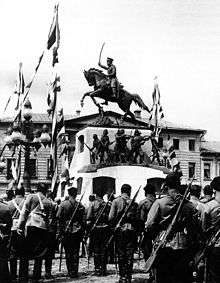
Before the opening of this statue of "the founder of Moscow" on the Soviet Square (formerly Tverskay Square before the October Revolution), this place was "on the lips of the Muscovites,"[1] and earned a reputation as "an unhappy place." The fact is that here during the 1912–1918 years the many statues monument of General Mikhail Skobelev was placed, who was a hero of the Russian-Turkish War in 1877-1878.
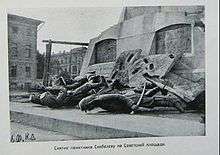
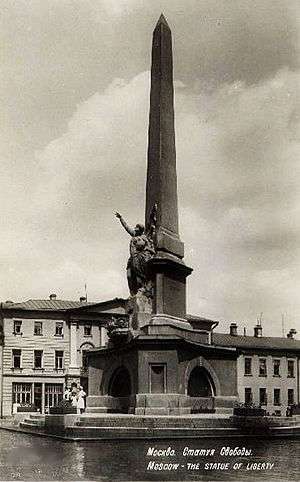
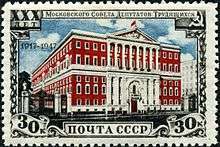
After the October Revolution, the Decree "About the removal of monuments of the tzars and their servants" was issued. According to this Decree the monument of "the white general" (he was called White General because he rushed into battle on a white horse) was overthrown.[2] Instead, the Constitution Obelisk was erected on the same place.[3]
26-meters three-edged column (obelisk) in honor of the Soviet Constitution came into sight in 1918, in front of Mossovet building (Moscow City Hall). Slim monument was supplemented by the Statue of Liberty in June 1919, sculptor Nikolay Andreyevich Andreyev, for which Vera Alekseyevathe posed (the niece of Konstantin Stanislavski).[4] According to another version the prototype of the Statue of Liberty became an actress of МХАТ Eugenie Khovanskaya, famous by own beauty.[5] The sculptor was inspired by the dynamic forms of the ancient statues of Nike of Samothrace, when he created this sculpture. The monument became interesting for Muscovites and even went to Moscow folklore; for example, the anecdote of those years:
- Why is the "Liberty" confront the Mossovet (Moscow City Hall)?
- Because the Mossovet con fronts the Liberty! [4]
The Monument of the Soviet Constitution was not stand long time also. By the end of the 1930s the monument required a restoration, as it was hastily made from ephemeral materials of low quality: the obelisk was built in brick and plastered "like a granite", a statue was casted in concrete. But before the restoration, shortly before the World War II, on the 22 of April 1941, the monument was destroyed on the pretext of clearing the area. "The Moscow lost the Freedom (Liberty)", - the name of article in Moscow press also includes a joke. The head of Statue of Liberty is in the Tretyakov Gallery and was placed in this gallery completely random.[5]
History of creation
As per the decision of the Soviet governance, the 800th anniversary of Moscow in September 1947 was planned to celebrate with a special scope. It was the first big, post-war celebration, seen as a "general rehearsal" of the 30th anniversary's celebrations of the October Revolution.
Traditionally, 1147 was considered the year Moscow City was founded, but really this year is only the first historical mention of Moscow. Already in the middle of the 20th century, most historians believed a settlement existed on the site of Moscow for at least 200 years before the knyaz Yuriy Vladimirovich Dolgorukiy, but the knyaz could not "establish" it. Still, it remains unclear whether the fortress was built by the knyaz Yuriy Dolgorukiy in this settlement (the village in 1147), or it existed before. Nonetheless, the anniversary celebration was conducted in accordance with the date, which has become traditionally accepted as the city's founding. The special attention was paid to Yuriy Dolgorukiy.
As per personal order of Joseph Vissarionovich Stalin, headed by archaeologist and anthropologist Mikhail Mikhaylovich Gerasimov, an expedition was outfitted even in Kiev in 1946, and the aim was to find the remains of Yuriy Dolgoruky. As per the idea of Joseph Stalin, the solemn reburial of knyaz remains should take place during the anniversary celebrations. However, the expedition was a failure; during the investigation of the "official" burial site of the knyaz, it was revealed that it is a false site.
In September of the same year, 1946, the competition for the best project of the monument took place. S.M. Orlov was announced as the winner of the competition. The sculptor was awarded the Stalin Prize for his work on this project. Russian writer, journalist, and historian Alexander Anatoliyevich Vas'kin insists that Stalin personally selected the Orlov's project among the other candidates, which was praised by the American Ambassador W. Averell Harriman during the Kremlin reception.[6]
Groundbreaking ceremony for the monument took place on September 6, 1947, during the celebration of 800th anniversary of Moscow. However, the capital would not soon see the monument. Disagreements took place constantly between co-authors. Sergey Orlov had never created large monumental sculptures before, he had created small sculptures only; he had a quarrelsome nature and it was hard to convince him that methods that work well for small, plastic art sculptures are not always suitable for monumental art.
Disputes took place not only between the co-authors, Orlov also clashed with the authorities. People who knew him well later said that the sculptor was categorically opposed to the text on the monument dedication, reading "To the founder of Moscow from the Soviet government." Oddly enough, he was able to defend their point of view and the Soviet government does not mention on the monument.[3] Insufficient funding also affected the speed of work: Moscow's anniversary marked the simultaneous launches of several large-scale projects, such as the building of the "Stalin skyscrapers"
Another legend tells about Stalin's approval of the final version of the monument. The leader carefully considered the model and said: "Why do you, Comrade Orlov, have Dolgorukiy sit on the mare? A stallion can accentuate the masculinity of the founder of Moscow." Replica was unexpected, the authors did not find any reply, but the changes were introduced to the projection immediately.[4][7] This legend received the peculiar continuation during the Khrushchev era.
The sculpture was produced on "Mytishchi Plant in honor national artist E.F. Belashova" by the sculptor and bronze caster Savinsky Gabriel Ivanovich, and it cost 5.5 million rubles from the city budget. The grand opening of the monument took place on the 6th of June, 1954.
Reception from Moscow citizens and Government leaders
The public reaction to this approved by the government monument was extremely negative. In the 1950s it was the only one monument in Moscow, does not reflect the ideology of the Communist Party.[8] It is surprising that in the late 1940s., during the Stalin's time, suddenly planned a monument of the knyaz, "exploiter of the peasantry and the tax collector of the feudal system."[9] Statue of Yuri Dolgoruky immediately provoked a mixed reaction both the general public and the Government leaders.
One legend says that when the tarpaulin cover was taken down, someone from the crowd shouted: "Well, is very looking like!" According to another version, the diametrically contrary was shouted: "Does not look like!" The first remark is attributed to the writer Zinovy Samoylovich Papernov; the second to the composer Sigizmund Abramovich Kats.[10] This episode indicates a stylistic inconsistency: the monument's symbolism of the semi-legendary personality was resolved in detail by including portrait with many components. The claim to historical authenticity, which was reinforced by the pathetic gesture of the bronze Knyaz, became an occasion for jokes.
The satellite-monuments
The creation of another monument for another city of the Soviet Union was also discussed in 1947-1948 and built in 1954. It was the Statue of Metallurgist Anosov, and this statue was not planned in honor of the 800th anniversary of Moscow. This statue in honor of governor and scientist -metallurgist Anosov Pavel Petrovich, which was in the rank equated to general, was erected in Zlatoust, Urals Military District, by Moscow sculptors A.P. Antropov and N.L. Strain and architect T.L. Shulgina on the 15 of December, 1954.[11] General-Major and scientist-metallurgist Anosov Pavel Petrovich was a Governor in Zlatoust district during the Tsar Russia period and also it is not clear why this anti-Soviet monument was created and Avosov hid behind the Metallurgist rank.
In 1955 was installed sculpture of Afanasiy Nikitin in Tver, the same sculptor Sergei Mikhailovich Orlov, who created the monument of Yuriy Dolgorukiy. But the sculpture of Afanasiy Nikitin was not anti-Soviet ideology monument. It was a monument of the first Russian merchant who visited and described the way to India.[12]
Above mentioned satellite-monuments means a doubt that the monument of Yuriy Dolgorukiy was planned in honor of 800th anniversary of Moscow as some historians declared. A fortiori, the monument was built in 1954 year, 7 years later, and the satellite-monuments can give plenty information. It is why the planning of the Monument of Yuriy Dolgorukiy to the 800th anniversary of Moscow has doubt, the sculpture was built later and installed in 1954.
To understand the situation will refresh some moments of the history.
- The leader of Soviet Union Joseph Stalin was more pleasure to the general Georgiy Zhukov after World War II. Stallin often asked advise from Zhukov and partly protected the general.
- Ural mountains were the center of the Soviet Union, not directly as per geometry, but due to mountains in the center of the big country was good for inside country connections and to hide any secret plant inside the mountains also. And the biggest shipping river Volga close to the Ural mountains. It is why the second and spare military and governor headquarters were close to Ural Mountains and Volga.
- So, the Soviet Union had two centers: one in Moscow and another somewhere in Ural Mountains and close to Volga River. And each center, as the World War II explained, must have code names. Knyaz Yuri Dolgorukiy, the monument was installed in front of Mossovet building, and Governor Anosov was good call names also for the leader of the Soviet Union and the general.
It was planned operation:

- Seems the operation was planned in 1947 about and needs time for preparations. So, from 1947 to 1954 preparations were in progress. After World War II more powerful countries tried to increase own territory of influence. Situation in India was favorable for the Soviet Union. The satellite-monument of Afanasiy Nikitin confirms the direction of Soviet interests as the Russian merchant described own voyage by the shore and by the seas to India. The complicity of the monument of Yuriy Dolgorukiy in Soviet operations against anti-British colonialism is confirmed by the nationality of Yuriy Dolgorukiy also. His mother was a daughter of one English King and Soviet actions could be looking like a struggle to receive a part of the colonial inheritance.
- The struggle on the Bengal territory, where is Bengal tigers territory also and one monument of the gun from British frigate Tiger in Odessa gave the name for this operation - "Tigers". But this operation was intelligence operations which was attached to other operations regarding India. And when was completed operations regarding Suez Canal, Yemen, India[13] the "Tigers" was continued together with new direction to Cuba.
- India received independence on 15 of August, 1947. The Soviet Union commenced to clean the seaways from own ports to Indian Ocean. For this reason plenty of ships were planned to be built. Arab-Israeli War from November 1947 to 14 of May 1948 was a struggle for the Suez Canal, that was continued in 1950s also.
- More close to the theatre was the Black Sea Shipping Company. The situation needs plenty merchant ships on the end of 1940s close to the theatre, in Black Sea Shipping Company, but the Black Sea Shipping Company had few ships after World War II. Urgently ships were transferred from other companies of the Soviet Union to the Black Sea Shipping Company. So, the following cargo ships were transferred from Far East Shipping Company to the Black Sea Shipping Company, which was only one Soviet Shipping company in Black Sea as all others were parted from the Black Sea Shipping company in 1960s:
- Белоруссия, Восток, Лермонтов, Плеханов, Тарас Шевченко from 1947 to 1949.
- Karaganda, Иркутск, Кавказ, Капитан Вислобоков were transferred in 1950. The ship Karaganda was used on the line between Black Sea Soviet ports and India ports.
- Аргунь (ex. West Modus from 1919 to 1942) was transferred in 1951.[14]
- The Kherson Shipyard for big sea-going ships was opened on beginning of 1950s and the first tanker-ships «Херсон» and «Грозный» were launched by this shipyard in 1953. The building of new cargo ships the shipyard commenced in some years.
- Other countries, including GDR, commenced to produce merchant ships for the Soviet Union in the end of 1940s and later. So, the cargo ships Smela and Nezhin were built in GDR for the Black Sea Shipping Company in 1954 and commenced to service the line from Black Sea Soviet ports to Egypt and Syria.
Odessa anti-Soviet ideology monuments
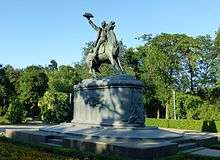
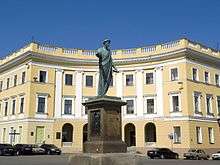
But Odessa was the home port for the ships of the Black Sea Shipping Company and this city also must have the code-monument. No any anti-Soviet ideology monument was built in Odessa in 1950s. It was already there.
- The Statue of Alexander Suvorov was created for Izmail in 1914, but due to Romania troops captured the Izmail the sculpture remained in the sculptor's workshop until middle of 1930s, when it was installed on the territory of Odessa Art Museum where was mentioned as an art sculpture and not as a monument. It is why this sculpture was not destroyed during dangerous for monuments 1920s-1930s years. The statue was in Odessa until 1945 when Izmail was back to the Soviet Union and this monument was returned to Izmail.[15]
- The Statue of Duke de Richelieu, who was one of the governors of Odessa in XIX century, was installed in 1828. But the Duke dressed in Rome toga and he was a Frenchman. Or due to he was looking like a poor man wrapped in bed sheet, or due to Frenchwoman {{:ru:Жанна Лябурб|Jeanne Labourbe}} added revolution group in Odessa after October Revolution to make propaganda of the French seamen for Antanta, this monument still stay in Odessa. But the Duke is not personage of Russia and as code-monument was used another monument.
- The Statue of Graf Vorontsov, Odessa, was opened in 1863. In 1930s the Soviet authorities tried to destroy this monument, but the chain, which was secured around to the monument and to a powerful tractor, parted. The monuments was not destroyed and to avoid any problem regarding ideology the citizens of Odessa used own famous humor. The Graf Vorontsov was a General-Governor of Novorossiya and Bessarabia with the center in Odessa when famous Russian poet Alexandr Pushkin visited Odessa. The Graf and the poet were not friendly and Alexandr Pushkin dedicated a short verse for the Graf, and the old label of the monument «Your Highness Knyaz Mikhail Semenovich Vorontsov from grateful countrymen. 1863 year.» was deleted and changed by Alexander Pushkin verse:
| Russian text of the verse | Translation on English |
| «Полумилорд, полукупец, Полумудрец, полуневежда, полуподлец, но есть надежда, Что будет полным наконец.»[16] | «A semi-milord, a semi-negociant, A semi-sage, a semi-ignorant, A semi-scoundrel, but hope is present That finally he will one hundred percent.» |
So, the Graf was berated by the Pushkin's verse, but his monument was not destroyed. Necessary to pay attention, that when Alexander Pushkin wrote this verse and the mutual understanding between the poet and Graf Vorontsov was absent fully, the Vasily Zhukovsky arrived in Odessa to clarify situation between Pushkin and Vorontsov. Vasily Zhukovsky was a poet and representative of Russian tsar regarding intelligence questions.
1954 year
- In 1954 Yuriy Andropov was appointed Soviet Ambassador to Hungary and held this position during the 1956 Hungarian Revolution.
- The Statue of Yuriy Dolgorukiy was opened in Moscow on the 6 of June, 1954.
- The Statue of Anosov was opened in Zlatoust on the 19 of December, 1954.[17]
- The shooting of Soviet movie Tamer of Tigers commenced in 1954. It was completed in 1955 and the movie soon received official English name Tiger Girl. Soviet artist Aleksander Aleksandrovich Orlov played the role of father of the tamer of Tigers Yelena Vorontsova in this movie. This movie and the Statue of Votontsov in Odess were involved in operation "Tigers".
Personages behind the monuments
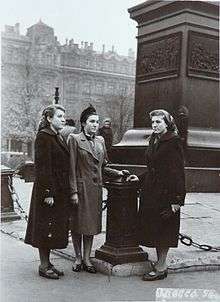
Of course the monument of Yuriy Dolgorukiy means Moscow center of intelligence leaders, Government leaders in Moscow. In 1954 Nikita Khrushchev and Frol Kozlov, who was an intelligence chief of Odessa city direction from Moscow, were behind this monument.
General Georgiy Zhukov was appointed a commander of the troops of the Odessa Military District from 9 of June 1946 to 4 of February 1948.[18] From 4 of February 1948 Zhukov became a commander of the troops of the Ural Military District. It is means that was behind the monument of Anosov.[19] Zhukov staying in Odessa from 1946 to 1948, during the preparatory period, means that he was well acquainted with the secret operations which were intertwined with Odessa and Black Sea Shipping Company during the Cold War from 1946 to 1967. It is means that was behind the Statue of Anosov due to the ship Metallurg Anosov was built in 1962 for the Black Sea Shipping Company.
Regarding the Statue of Graf Vorontsov, Odessa, a little more information. On the photo on the right sisters of Zhukovsky family at this monument in 1954 year, the year when monuments of Yuriy Dolgorukiy and of Anosov were built. It is possible to call this photo as a key-photo. Their father Grigoriy Zukovskiy was under KGB control. This family was involved in operation "Tiger" from 1961 about and other persons in Odessa city, who were behind this family, ruled the game as per directions from Moscow and from Georgiy Zhukov and Leonid Brezhnev. That other persons were changed sometimes and in 1980–1999 years some members of Orlov family were placed behind Zhukovsky family in Odessa. In XVIII century Grigory Orlov received Graf title from Yekaterina II and the monument of Graf Vorontsov was very good match for them.
The first name of Yuri Dolgorukiy, Yuri or Yuriy directly, became a markable in intelligence services of the Soviet Union. So, Yuriy was born in Zhukovskiy family in Odessa in 1962 and Yuriy Orlov of Orlov family arrived in Odessa in 1980 about.
Yuriy Andropov
In 1954 Yuriy Andropov, full official name is Yuriy Vladimirovich Andropov, was appointed Soviet Ambassador to Hungary and held this position during the 1956 Hungarian Revolution. Andropov played a key role in crushing the Hungarian uprising. Seems, Yuriy Dolgorukiy name, full name of this knyaz was Yuriy Vladimirovich Dolgorukiy, was used during this years. Moscow intelligence center used name Yuriy Dolgorukiy for recruitment as a target for promotion. To be a leader in Moscow - it was the aim of Andropov and it was possible in case positive result in Hungary.
One of the sculptors of the monument of Yuriy Dolgorukiy was A.P. Antropov[20] and in some sources this sculptor mentioned as A.P. Andropov.[21] It is also confirmation that this monument something meant for Yuriy Andropov from beginning, when he was appointed Soviet Ambassador in Hungary.
Later, when Andropov became a leader of KGB, he was associated with Yuriy Dolgorukiy. And mostly school boys named Yuriy were recruited by KGB in 4th school class about, when they was taught Russian history and understood that Yuriy Dolgorukiy was a Moscow knyaz and nothing bad was in school program about this knyaz. The recruitment commenced from idea to be a leader in Moscow as he and knyaz have one name and plus he has good result in school and can be a leader of country. "It was hammered into the brains" - clear Russian phrase. Later the school boy was involved in any school tussle and suddenly he received support, sometimes unvisible, and understand that KGB gave support to him. One by one, and he commences to read orders and follow directions until he will used as KGB cannon fodder. Often it was zombie preparations.[22]
Due to Yuriy Andropov was a chief of KGB, the code-name Yuriy Dolgorukiy became a first name of KGB. Dolgorukiy can be translated as "long hand" (Russian: Долгая Рука - Dolgaya Ruka), but on Ukranean language,the Russian language really commenced from Kiev Rus and Ukrainean is close to old Russian language, (Ukrainian: Довга Рука - Dovga Ruka or Dovgorukiy, or Dolgorukiy) "long hand" has two meanings:
- long size hand;
- long range possibilities hand.
So, Dolgorukiy means a person or organization that able to reach anybody anywhere due to has very long hands (long range hands). This is terribly when a school boy understand finally in which hands he is.
Yuri Brezhnev
Leonid Brezhnev inherited the ship Metallurg Anosov and Statue of Anosov from the Georgiy Zhukov and he had sobriquets:
- Леонид Заведывающий - can be translated on English "Leonid Governor".
- Бровеносец в потемках - on English "The eyebrows carrier in the darkness" due to he had bushy eyebrows. It was parody from the name of the battleship Броненосец Потёмкин which got uprising at Odessa.[23]
His son Yuri Brezhnev was one of the applicants to receive the title of Yuri Dolgorukiy, but he yanger than Andropov. While Leonid Brezhnev was alive, his children did not make opposition one to Andropov.
Other Yuriy-s
It is necessary to refresh in memory other persons that had name Yuriy during that period and was not involved directly into above mentioned operation, but their success and filming was used in 1960s and later during the ensuing operations:[24]
- Yuriy Gagarin (1394-1968) - the first cosmonaut. Another cosmonaut was planned as the first man in the Cosmos, but he was changed to Yuriy Gagarin.
- Yuriy Yakovlev (Soviet actor) (1928-2013) - a Soviet actor of theatre and cinema
- Yuriy Solomin (1935- ) - a Soviet actor of theatre and cinema became a famous actor after the filming of the Soviet movie "The Adjutant of His Excellency" about the intelligence services during the Russian Civil War.
- Yuriy Nikulin (1921-1997) - a Soviet actor of the cinema and the circus became a famous actor after the filming of Comic Soviet movies.
- Yuri Senkevich (1937-2003) - a Soviet doctor, and scientist. He is a Candidate of Sciences. He became famous in the USSR and worldwide for his participation in the Ra Expedition, in which he sailed together with Thor Heyerdahl.[25] In 1973, Senkevich began his career as a host of the "Travelers' Club" (Клуб путешественников), a show on the Soviet Central Television. But the TV was used as a possibilities to transmit a special or secret information to unknown person or persons also.
Finally from 1950s became era of Yuriy-s in the Soviet Union, and era of the Monument of Yuriy Dolgorukiy also. After the first fly of Yuriy Gagarin into the Cosmos plenty newborn boys of the Soviet Union were named Yuriy, - It was a lot of material for the Yuriy Dolgorukiy's KGB.
1960s
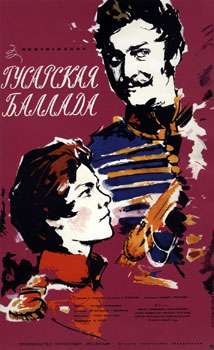
- 12 of April, 1961. Russian Soviet pilot and cosmonaut Yuriy Gagarin made the first human to journey into outer Space on Soviet space-ship Vostok. Plenty newborn boys of the Soviet Union were named Yuriy after this journey.
- 1962 year.
- Due to 150-anniversary of the War of 1812 (Russia), the Soviet musical film "Hussar Ballad" was completed and filmed by Eldar Ryazanov on Mosfilm. In effect, it is one of the best loved musical comedies in Soviet Union. The main roles were played by Yuriy Yakovlev and Larisa Golubkina. Historic character Vasily Zhukovsky was distorted in the film. In future this movie personages tried to combine with the Zhukovky family in Odessa: Soviet intelligence play tried to use Poruchik Rzhevskiy behavior;[26] "The Napoleon" Soviet intelligence operation also was born after this movie.[27]
- In 1962 it issued A decree of the Central Committee of the CPSU and the USSR Council of Ministers "About the reconstruction of Monument of Liberty on the Soviet square (on the place of monument of Yuriy Dolgorukiy) to 7 of November, 1964" was issued in 1962. Monument of Yuri Dolgoruky was planned to move to the square near the Novodevichy Monastery. However, in October 1964, Khrushchev was deprived of all his posts. But the monument was not replaced.
- New Soviet cargo ship Metallurg Anosov was launched in Kherson Shipyard in July, 1962. The construction of this ship was completed, including trials, and the ship was handed over to Black Sea Shipping Company on the 29 of September, 1962.[28] It was only one ship in all merchant fleet that was named in honor of Governor of Tsar Russia Anosov Pavel Petrovich. And, seems, until middle of 1970s or can be until the disintegration of the Soviet Union only this ship had anti-Soviet ideology name. Anosov was represented as a Scientist-Metallurg first of all. The monument of Anosov in Zlatoust was not enough.
Gentlemen of Fortune (He ia a Monument!)
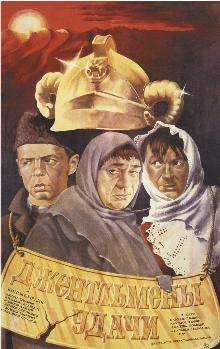
The Soviet detective comedy film Gentlemen of Fortune (Russian: Джентльмены удачи, translated as: Dzhentlmeny udachi) is a Soviet comedy, which was filmed at Mosfilm in 1971. The film was the leader of Soviet distribution in 1972 having 65.02 million viewers.
But from beginning this movie was not so interesting as the Gaidai comedy films were more beautiful and interesting. There is not everybody understood all jokes due to the jokes have some secrets. The mentioned episode could more better understood the citizens of Moscow as the Monument (Sculpture) of Yuriy Dolgorukiy, and first of all the most citizens of the Soviet capital understood that it has context regarding Yuriy Andropov, who became more powerful from 1971.
Russian jargon "to sit" (Russian: сидеть) means also "to be imprisoned" due to in any Soviet prison а prisoner is not run or walk, he was sitting mostly on the bank. And every Soviet people understood this jargon, but not every know about the relationship between Yuriy Andropov and the monument.
Russians separate sculptures not the same as in England or in the USA. The statue for Russian it is human full body sculpture (can include horse, armchair, e.t.c.) if this statue is installed inside museum, exhibition hall, big park. But the high ideology "Monumental Statue", which installed in the city like a monument, Russians named it Monument.
Also Russians have no difference in words "it" and "he" if it a masculine noun, - "он" is "he" and "it" in this case. The word "monument" is a masculine noun.
In this movie one ex-prisoners were searching one building in the city and one of them, who was there before, explained the taxi driver that there was a tree, when he was there last time. The taxi run plenty kilometers and the search was unsuccessful until one prisoner asked another one, who was there:
- Is any monument there?
And the ex-visitor of that place said that there was a monument of man. When taxi driver asked:
- Is he sitting?
- Who? - re-asked the ex-visitor and ex-prisoner.
- That your man - reply taxi driver about a Sculpture of a Man (on Russian: The Monument).
- Lo, village people (about the taxi driver)! I said to you: "It is the Statue (on Russian: Monument)!" Who is able to sit it (him) (on Russian: it and him are the same)? He (it) is a Monument!
Pay attention that for any Russian prisoner "to sit" means "to be imprisoned". The Statue was not showed yet and Soviet cinema visitor understood that a chief of the KGB Yuriy Andropov has nickname Yuriy Dolgorukiy and in this comparison Yuriy Andropov is a Monument (Statue for the English peoples) and impossible "to sit" this monument.
Three cuts of this episode are in the Internet and you can see it from the very short episode and complete with the longer one:
- Who is able to sit it (him)? He (it) is a Monument! Он же памятник! (Russian: Кто ж его посадит? Он же памятник!) (Very short episode).
- Кто ж его посадит? Он же памятник!
- Кто ж его посадит? Он же памятник! (Long episode).
And Yuriy Andropov got one more nickname "Monument" (on English: "Monumental Statue") from 1971. When in 1976 the Statue (Monumental Bust) of Leonid Brezhnev was installed in Dneprodzerzhinsk,[29] and Russian customs do not permit to install a monumental statue of anybody alive, Soviet peoples said about the Soviet leaders: "All they are "Monuments"! And more Soviet people understood the film Gentlemen of Fortune joke.
The same about the Monumental Statue of Great Knyaz Vladimir in Moscow (November, 2016), which can be related to the leader of Russia Vladimir Putin. And the film's joke "Who is able to sit it (him)? He (it) is a Monument!" (Russian: "Кто ж его посадит? Он же памятник!") again has continuetion.
References
- ↑ Soviet, Russian folk jargon, which means that Moskovites were talking about it often.He is holding out his right hand''Italic text Moskovites are citizens of Moscow.
- ↑ The general Skobelev used white parad tunic (uniform) and white horse during the Russian-Turkish War (1877-1878) and after Great October Socialist Revolution the population was divided during the Russian Civil War: bolsheviks and their supporters were the "Reds", and tsar military and their supporters were the "Whites".
- 1 2 Title: Всегда и во всём быть художником. Publisher: Мир истории. Published in January, 2002. Accessdate: 2009-02-08. Language: Russian.
- 1 2 3 "Всадники и Статуя Свободы на Тверской площади". Москва. Назад в будущее. Что было — что стало. RetroMoscow. Archived from the original on 2012-03-19. Retrieved 2009-02-08.
- 1 2 Беляева, Екатерина (2006-10-28). "Москва потеряла свободу". МК-Суббота. Archived from the original on 2007-05-18.
- ↑ Author: Васькин, Александр. Title: Тверская улица в домах и лицах. Published by Центрполиграф, Moscow, date 2015. Total pages: 236.
- ↑ "7 сентября в истории". NewsInfo. Published on 7 of September, 2008. Archived from the original on 2012-03-19. Retrieved 2009-02-08.
- ↑ Тонкости Туризма >> Памятник Юрию Долгорукому в Москве
- ↑ Прогулки по Москве >> Памятник Юрию Долгорукому
- ↑ Author: Алексей Митрофанов. Title: Прогулки по старой Москве. Тверская. Publisher: Ключ-С, Moscow. Date 2006. ISBN 5-93136-024-7
- ↑ Златоуст >> Памятник П. П. Аносову.
- ↑ ВОТПУСК.RU >> Достопримечательности >> Россия - Центральный р-н >> Тверь >> Памятник Афанасию Никитину
- ↑ I dont know their names.
- ↑ Тип "Белоруссия" (пр. 1013) - 25 единиц.
- ↑ Любимый Измаил >> Кочующий памятник (версии и факты).
- ↑ Одесский Портал >> Памятник М.С. Воронцову в Одессе
- ↑ Златоуст >> Памятник П. П. Аносову
- ↑ Author: Краснов В. Г. - Title: "Жуков. Маршал великой империи. Лавры и тернии полководца." — М.: Олма-Пресс, 2005. — page 576 — 3000 copies. — ISBN 5-224-04783-8.
- ↑ Author: Млечин Л. М. - Title: "Кремль-1953. Борьба за власть со смертельным исходом." — М.: Центрполиграф, 2016. — page 408 — 3000 copies. — ISBN 978-5-227-06417-2.
- ↑ To see beginning of this article.
- ↑ intoMOSCOW.ru » Главная»Достопримечательности » Памятники»Памятник Юрию Долгорукому
- ↑ Selfintevew: "I passed this way. First time I was explained by unvisible voice that I really can be Yuriy Dolgorukiy. It was in 1972 about, when I was 9 years old about and was studiet in the 4th class of a school in Odessa. Once my friend suddenly smile, directed own finger to me and cry to me in school class-room: "You are Andropov!" It was 1977 about. I understood that Yuriy Andropov and Yuriy Dolgorukiy is the same face. After this show in class boys from senior class started beating my friend in school's hall and I came close to stop it. Soon I understood who is a Yuriy Dolgorukiy really and who is a doll Pinocchio. In the end of 1990s I was informed that it was misunderstanding between Yuriy Brezhnev and Yuriy Andropov - To whom I belong? Other talkings are my Private Matter."
- ↑ Какие прозвища давали русским правителям.
- ↑ I have to mentioned that I was named Yuriy due to Yuriy Gagarin became famouse in 1960-s and all other down mentioned Yuriys were involved in my activity but not by me. Seems they did not know about me nothing or were informed partly. Most likely their work was used and sent to secret actions of Ruzvedupr. Also every artist wanted to be famouse and was anree to be used for like this activity often.)
- ↑ Когда в гостях был целый мир. Статья о Юрии Сенкевиче и «Клубе путешественников». Официальный сайт Всемирной энциклопедии путешествий
- ↑ Selfintervew: "It was not very good idea that did not reached a complete success. The stupid and rude jokes Lieutenant Rzhevsky very bored ray and were often inappropriate. But, considering the complexity of resentment and other misunderstandings in the intelligence activities, finally was received a wonderful and unrivaled character of Chicot."
- ↑ The Napoleon is a cod name for the Russian as in can be translated as "Na pole on" and on Russian is "На поле он" (English: He is on the open field). It is means that "he is visible", becouse no any trees around.
- ↑ My birthday
- ↑ Памятник Мой Дн Дз >> Брежневу Л.И.
To see also
- Statue of Graf Vorontsov, Odessa
- Statue of Metallurgist Anosov, Zlatoust
- Metallurg Anosov (ship, 1962)
- SS Nezhin
- Mister X (1958 film)
- SS Karaganda
- SS Metallurg Anosov
.jpg)